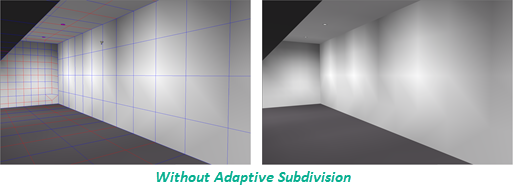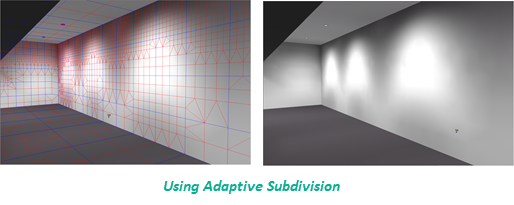
Adaptive Subdivision - Concepts
Adaptive Subdivision changes the sampling level of all surfaces based on the electric lighting and/or daylighting beam patterns to create more accurate representations of the beam's interactions with the surfaces. Applying Adaptive Subdivision generally results in more accurate renderings and calculated values, with the necessary penalty of slightly longer calculation times. We recommend Adaptive Subdivision be applied to all Full Radiosity Method calculated environments as a minimum before the final results are outputted from AGi32. For certain environments it should be used as a rule (see importance below).
The differences can be quite dramatic in some circumstances.


Why is Adaptive Subdivision Important?
Adaptive subdivision increases the number of Elements (receivers) inside each Patch of the radiosity mesh enabling a finer gradient of calculated luminance for each surface (be sure and read the Calculation Concepts topic for reference regarding Radiosity Elements and Patches). The default mesh with Adaptive Subdivision disabled is designed to be adequate for the computation of work plane illuminance in a uniform space with uniform luminaire layout. When environments become irregular in shape and light sources get close to surfaces, or calculation points, the software needs a way to treat the environment more rigorously. Using Adaptive Subdivision is the easiest way to increase to rigor of the calculation.
Adaptive Subdivision is only step one when refining the radiosity mesh to accommodate your application and you may find even the top setting of adaptive subdivision cannot solve some radiosity issues such as "patch leak". Why? Remember, adaptive subdivision ONLY increase the number of Elements (receivers) in the mesh. It does NOT increase the number of Patches (emitters). You can adjust the number of Patches on individual surfaces (or many) using Surface Edit. Please refer to the Mesh Level topics for more information.